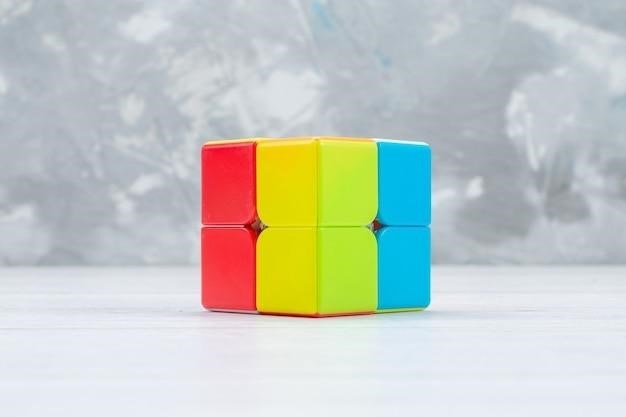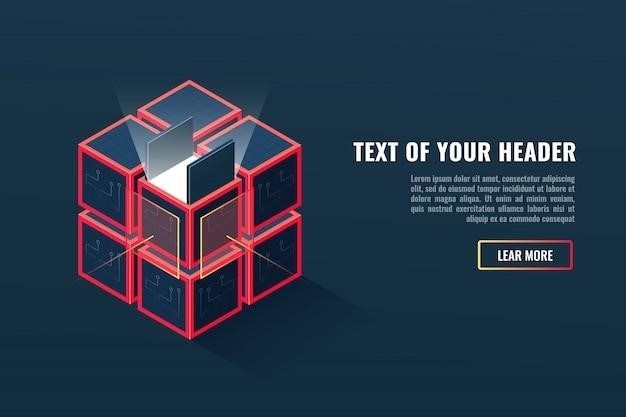Understanding the 2×2 Rubik’s Cube
The 2×2 Rubik’s Cube, also known as the Pocket Cube, is a smaller version of the classic 3×3 cube. It features only corner pieces, making it a great entry point for beginners. Numerous online resources, including PDFs, provide step-by-step solutions and algorithm guides.
Introduction to the 2×2 Cube
The 2×2 Rubik’s Cube, often called the Pocket Cube, is a simplified version of the 3×3 cube. Unlike its larger counterpart, it lacks center and edge pieces, containing only eight corner pieces. This reduction in complexity makes it an ideal starting point for beginners learning to solve Rubik’s Cubes. Many online resources offer beginner-friendly guides and tutorials, frequently presented as downloadable PDFs. These resources typically break down the solution process into manageable steps, often utilizing intuitive methods rather than complex algorithms initially. Mastering the 2×2 is a stepping stone to tackling more challenging cube variations.
Comparison with the 3×3 Cube
While sharing the core concept of a rotating cube puzzle, the 2×2 and 3×3 Rubik’s Cubes differ significantly in complexity. The 2×2, with only corner pieces, presents a much simpler challenge. Solving techniques often mirror those used for the 3×3’s corners but are less intricate due to the absence of edge and center pieces. This lack of edge and center pieces means fewer possible configurations and simpler algorithms. Many find the 2×2 a valuable training ground, allowing them to practice intuitive manipulation and spatial reasoning before progressing to the greater challenge of solving a 3×3. PDF guides frequently highlight this relationship, using the 2×2 as a simplified introduction to the fundamental principles of Rubik’s Cube solving.
Solving the First Layer
Begin by choosing a color and solving one corner. Then, strategically manipulate the cube to complete the remaining three corners of the first layer, creating a solid base for the next stage. Many online PDFs illustrate this process visually.
Completing the First Corner
To begin solving the first layer of your 2×2 Rubik’s Cube, select a color to serve as your starting point. Most beginners choose white or yellow. Locate a corner piece that contains this color. Using intuitive moves, bring the other three corner pieces into proximity with this chosen corner. This process involves rotating the cube’s faces to bring the correct pieces into alignment. The goal is to position one corner piece correctly, setting the stage for completing the rest of the first layer. Remember, there are no edge pieces to consider in a 2×2; your focus is entirely on the corner pieces. Many online tutorials and PDFs offer visual aids and step-by-step instructions for this initial crucial step. Practice is key to mastering this phase; don’t be discouraged if it takes some time to get comfortable with the movements.
Completing the Remaining Corners
Once you’ve successfully placed the first corner piece, you’ll need to complete the remaining three corners of the first layer. This involves strategically maneuvering the remaining three corner pieces into their correct positions. Similar to solving the first corner, this process relies on intuitive rotations and careful observation. You’ll need to identify which corner piece needs to move and then execute a series of rotations to move it into its designated spot, maintaining the position of the already solved corner. Various methods exist, some relying on specific algorithms, others on intuitive problem-solving. Many online resources, including helpful PDFs, visually demonstrate these moves. Remember to focus on one corner at a time, ensuring each is correctly positioned before moving on to the next. With practice, you’ll quickly develop a feel for the efficient movements required to complete this stage.
Solving the Last Layer
With the first layer complete, focus on orienting and permuting the last layer’s corners. Many online resources, including PDFs, offer algorithms to efficiently solve this final step.
Orienting the Last Layer Corners
Once the last layer corners are in their correct positions, you need to orient them correctly. This involves matching the colors of each corner piece to the adjacent faces. Several methods exist, often detailed in online 2×2 Rubik’s Cube solution PDFs. These methods typically involve a series of algorithms—sequences of moves—that rotate specific corners without disturbing the rest of the cube. Some popular algorithms for orienting last layer corners include simple two-step rotations or more complex sequences designed for speedcubing. The choice of method depends on your preferred solving style and comfort level with algorithms. Remember to carefully follow the instructions and diagrams provided in your chosen resource to avoid mistakes. Practice is key to mastering these algorithms and achieving fast and efficient solutions. Many tutorials offer visual aids, making learning these crucial steps much easier.
Permuting the Last Layer Corners
After orienting the last layer corners, the final step involves permuting them—arranging them in their correct positions. This often requires algorithms that swap or cycle corners. Many online 2×2 Rubik’s Cube solution PDFs offer various algorithms for this stage. These algorithms might involve rotating the top layer and potentially other layers to achieve the correct arrangement. The complexity of the algorithms can vary, with simpler methods suitable for beginners and more advanced techniques for speedcubers. Visual aids and diagrams found in many online resources are extremely helpful in understanding the sequences of moves involved. Careful execution of these algorithms is crucial; even a single incorrect move can disrupt the progress made and necessitate starting again from a previous step. Practice is key to memorizing and efficiently executing these corner permutation algorithms.

Utilizing Algorithms and Notation
Many 2×2 Rubik’s Cube solution PDFs utilize standardized notation to describe algorithms. Learning this notation is crucial for understanding and applying the provided solution steps efficiently.
Understanding Algorithm Notation
Many online resources and downloadable PDFs for solving the 2×2 Rubik’s Cube utilize a concise notation system to represent sequences of moves. This notation typically uses single letters (like F, B, R, L, U, D) to represent 90-degree clockwise rotations of specific faces of the cube. For example, ‘F’ denotes a clockwise turn of the front face, while ‘F2′ represents a 180-degree turn. Counter-clockwise rotations are often indicated by adding an apostrophe (e.g., F’). Understanding this system is key to interpreting the algorithms presented in solution guides. Different resources might have slight variations, so checking the notation legend within each PDF is advisable. Mastering this notation allows efficient execution of complex sequences, crucial for faster solving times and smoother transitions between steps. Practice is essential to internalize these symbols and their corresponding movements.
Finding and Using PDF Resources
Numerous websites and online communities dedicated to speedcubing offer downloadable PDF guides for solving the 2×2 Rubik’s Cube. A simple web search for “2×2 Rubik’s Cube solution PDF” will yield many results. These PDFs often contain visual aids, such as diagrams and illustrations, to complement the written instructions. Some PDFs cater to beginners, offering simplified methods, while others delve into more advanced techniques. When choosing a PDF, consider the level of detail and the clarity of the instructions. Look for resources with clear notation explanations and multiple images to illustrate each step. Ensure the PDF is well-formatted and easy to navigate. After downloading, print the PDF or utilize a device for easy reference during the solving process. Remember to compare your cube’s state to the images in the PDF to avoid mistakes. Many free resources are available; however, some sites might offer premium PDFs with additional features or more advanced strategies.

Advanced Techniques and Resources
Beyond beginner methods, explore advanced techniques like the Ortega method. Many speedcubing websites and YouTube channels offer tutorials and PDFs detailing these efficient strategies.
Ortega Method for 2×2
The Ortega method is a popular and efficient approach for solving the 2×2 Rubik’s Cube. Unlike beginner methods that solve layer by layer, Ortega focuses on solving the last layer in a more intuitive way. It involves a series of algorithms and intuitive steps to orient and permute the last layer corners simultaneously, leading to faster solve times. Many online resources provide detailed instructions and algorithm charts for the Ortega method. You can find these resources in various formats, including helpful PDFs and video tutorials. Learning the Ortega method requires memorizing several algorithms, but the significant increase in speed often makes the effort worthwhile for those seeking to improve their 2×2 solving skills. The method is particularly effective for speedcubers aiming for faster times, going beyond the basic layer-by-layer approach. Remember to practice consistently to master the required algorithms and transitions between steps.
Speedcubing Resources and PDFs
Numerous websites and online communities cater to speedcubers of all levels, offering a wealth of resources for solving the 2×2 Rubik’s Cube. These resources often include downloadable PDFs containing detailed instructions, algorithm sheets, and visual aids. Many experienced cubers share their methods and techniques through tutorials and guides available in PDF format. These documents often use standardized notation to represent cube moves, making them easily understandable. Beyond PDFs, you’ll find videos demonstrating various solving techniques, from beginner methods to advanced strategies like the Ortega method. These video tutorials are often accompanied by downloadable PDF sheets summarizing the algorithms presented. Websites dedicated to speedcubing also sell physical algorithm sheets, but free online PDFs serve as an excellent starting point for learning and improving your 2×2 solving skills. Exploring these resources is key to unlocking faster and more efficient solving techniques.